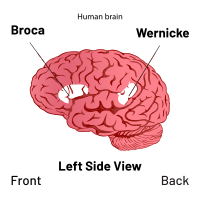Portal:Linguistics
- For a topical guide of this subject, seeOutline of linguistics
Welcome to the Linguistics Portal!Linguisticsis the scientific study oflanguage.Linguistics is based on a theoretical as well as a descriptive study of language and is also interlinked with the applied fields of language studies and language learning, which entails the study of specific languages. Before the 20th century, linguistics evolved in conjunction with literary study and did not employ scientific methods. Modern-day linguistics is considered asciencebecause it entails a comprehensive, systematic,objective,and precise analysis of all aspects of language – i.e., thecognitive,thesocial,thecultural,thepsychological,the environmental, the biological, the literary, the grammatical, thepaleographical,and thestructural. Traditional areas of linguistic analysis correspond tosyntax(rules governing the structure of sentences),semantics(meaning),morphology(structure of words),phonetics(speech sounds and equivalent gestures insign languages),phonology(the abstract sound system of a particular language), andpragmatics(how socialcontextcontributes to meaning). Subdisciplines such asbiolinguistics(the study of the biological variables and evolution of language) andpsycholinguistics(the study of psychological factors in human language) bridge many of these divisions. Linguistics encompassesmany branches and subfieldsthat span both theoretical and practical applications.Theoretical linguistics(including traditional descriptive linguistics) is concerned with understanding theuniversalandfundamental natureof language and developing a general theoretical framework for describing it.Applied linguisticsseeks to utilize the scientific findings of the study of language for practical purposes, such as developing methods of improving language education and literacy. Linguistic features may be studied through a variety of perspectives:synchronically(by describing the structure of a language at a specific point in time) ordiachronically(through the historical development of a language over a period of time), inmonolingualsor inmultilinguals,among children or amongst adults, in terms of how it is being learnt or how it was acquired, as abstract objects or as cognitive structures, through written texts or through oral elicitation, and finally through mechanical data collection or through practical fieldwork. (Full article...) Selected article -Inphonology,minimal pairsare pairs ofwordsor phrases in a particularlanguage,which differ in only one phonological element, such as aphone,phoneme,tonemeorchronemeand have a distinct meaning. They are used to demonstrate that twophonesconstitute two separate phonemes in the language. As an example forEnglishvowels,the pair "let "+" lit "proves that thephones[ɛ](in let) and[ɪ](in lit) do in fact represent distinct phonemes/ɛ/and/ɪ/.An example for Englishconsonantsis the minimal pair of "pat "+"bat ". In phonetics, this pair, like any other, differs in number of ways. In this case, the contrast appears largely to be conveyed with a difference in thevoice onset timeof the initial consonant as the configuration of the mouth is same for[p]and[b];however, there is also a possible difference in duration, which visual analysis using high quality video supports. Did you know...From Wikipedia's "Did You Know"archives: 
Related PortalsThings you can do
WikiProjectsThe followingWikiProjectswork to improve topics concerned with linguistics:
Associated WikimediaThe followingWikimedia Foundationsister projects provide more on this subject:
Discover Wikipedia usingportals |



























